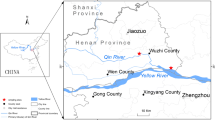Abstract
Fine-scale fabric within shales can be used to interpret environments of deposition. In particular, systematic variations in lamina thicknesses can be used to suggest the presence or absence of specific sedimentological controlling factors, such as tides. Herein, shale fabric is analyzed from Carboniferous coal-bearing and siliciclastic-rich formations in Indiana and Kansas. The shales exhibit well developed, normally graded lamina. Sediment grain sizes range from silt and sand at the base of the lamina up to silt and clay at the top. Computer-based optical scanning of prepared shale samples was undertaken so that the lamina thicknesses could be extracted automatically and then used for thickness-series analysis. The sands and silts tend to be very light in color because they consist of well sorted, quartz-rich sands. Conversely, the silt and clay that cap the laminae tend to be dark because of the small grain size; such fine-grained layers also contain large amounts of macerated and coalified plant material. Grain size and sedimentological differences within the laminae can be detected by optical properties and this facilitates automated image processing. Extraction of laminae thicknesses and harmonic analyses of laminae-thickness series can then be used to test the reasonability of specific environmental processes, such as tidal forcing, that were operative during the formation of these shales.
Similar content being viewed by others
References
Archer, A. W., 1991, Modeling of tidal rhythmites using modern tidal periodicities and implications for short-term sedimentation rates,in E. K. Franseen, W. L. Watney, C. G. St. C. Kendall, and W. C. Ross (Eds.),Sedimentary Modeling: Computer Simulations for Improved Parameter Definition: Kansas Geological Survey Bulletin, V. 233, p. 185–194.
Archer, A. W., and Clark, G. R., II, 1992, Depositional environment of theDunbarella beds: An exercise in paleoecology and sediment cyclicity,in J. Zideck (Ed.)Geology and Paleontology of the Kinney Brick Pit Quarry, Late Pennsylvanian, Central New Mexico: New Mexico Bureau of Mines and Mineral Resources Bulletin, v. 138, p. 27–36.
Archer, A. W., Kvale, E. P., and Johnson, H. R., 1991, Analysis of modern equatorial tidal periodicities as a test of information encoded in tidal rhythmites,in D. G. Smith, G. E. Reinson, B. A. Zaitlain, and R. A. Rahmani (Eds.),Clastic Tidal Sedimentology: Canadian Society of Petroleum Geologists Memoir, v. 16, p. 189–196.
Dalrymple, R. W., Makino, Y., and Zaitlin, B. A., 1991, Temporal and spatial patterns of rhythmite deposition on mud flats in the macrotidal Cobequid Bay—Salmon River estuary, Bay of Fundy, Canada,in D. G. Smith, G. E. Reinson, B. A. Zaitlain, and R. A. Rahmani (Eds.),Clastic Tidal Sedimentology: Canadian Society of Petroleum Geologists Memoir, v. 16, p. 137–160.
Demko, T. M., Jirikowic, J., and Gastaldo, R. A., 1991, Tidal cyclicity in the Pottsville Formation, Warrior Basin, Alabama: Sedimentology and time-series analysis of a rhythmically laminated sandstone-mudstone interval: Geol. Soc. Am. (Abstracts with Programs), v. 23, n. 5, p. A287.
Horne, J. H., and Phliunas, S. L., 1986, A prescription for period analyses of unevenly sampled time series: Astrophys. J., v. 302, p. 757–763.
Klein, G. deV., 1977,Clastic Tidal Facies: Continuing Education Publication Company, Champaign, Illinois, 49 p.
Keucher, G. J., Woodland, B. G., and Broadhurst, F. M., 1990, Evidence of deposition from individual tides and of tidal cycles from the Francis Creek Shale (host rock to the Mazon Creek Biota), Westphalian D (Pennsylvanian), northeastern Illinois: Sediment. Geol., v. 68, p. 211–221.
Kvale, E. P., and Archer, A. W., 1990, Tidal deposits associated with low-sulfur coals, Brazil Formation (Lower Pennsylvanian), Indiana: J. Sedimen. Petrol. v. 60, p. 563–574.
Lindley, C. A., 1991,Practical Image Processing in C: John Wiley, New York, 554 p.
Macleod, N., 1990, Digital images and automated image analysis systems,in F. J. Rohlf, and F. L. Bookstein (Eds.),Proceedings of the Michigan Morphometrics Workshop: University of Michigan Museum of Zoology, Special Publication No. 2, Ann Arbor, Michigan, p. 21–36.
Nio, S. D., and Yang, C. S., 1989, Recognition of Tidally-influenced Facies and Environments (Short Coarse Note Series 1 ed.): Reaal 5, 2353 Leiderdorp, Netherlands, Intergeos, International Geoservices BV, 230 p.
NOAA, 1990, Tide tables, 1991, high and low water predictions, Central and Western Pacific Ocean and Indian Ocean: National Oceanic and Atmospheric Administration, U.S. Department of Commerce, 6501 Lafayette Ave., Riverdale, Maryland, 381 p.
Reineck, H. E., and Wunderlich, F., 1968, Classification and origin of flaser and lenticular bedding: Sedimentology, v. 11, p. 99–104.
Tessier, B., 1993, Upper intertidal rhythmites in the Mont-Saint-Michel Bay (NW France): Perspectives for paleoreconstruction: Marine Geol., v. 110, p. 355–367.
Author information
Authors and Affiliations
Rights and permissions
About this article
Cite this article
Archer, A.W. Extraction of sedimentological information via computer-based image analyses of gray shales in carboniferous coal-bearing sections of Indiana and Kansas, USA. Math Geol 26, 47–65 (1994). https://doi.org/10.1007/BF02065875
Received:
Accepted:
Issue Date:
DOI: https://doi.org/10.1007/BF02065875




